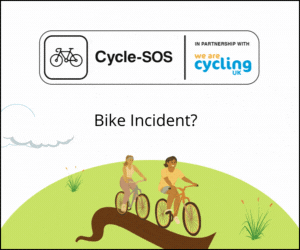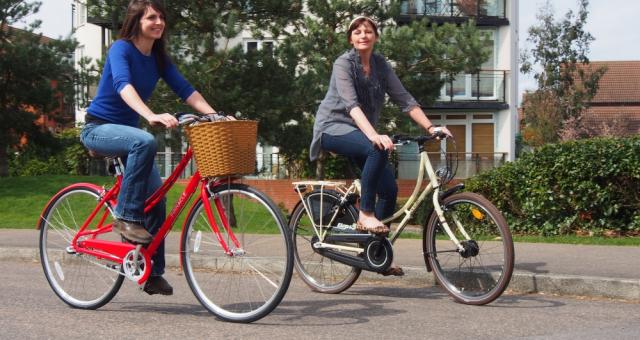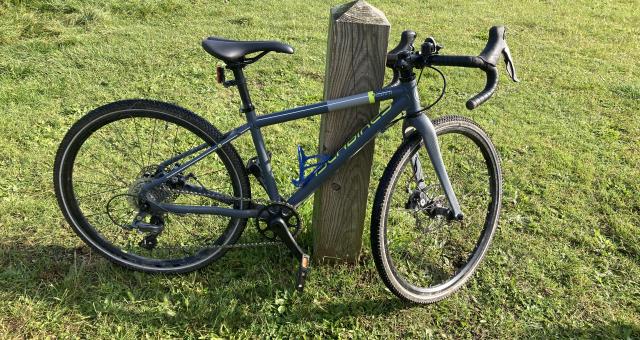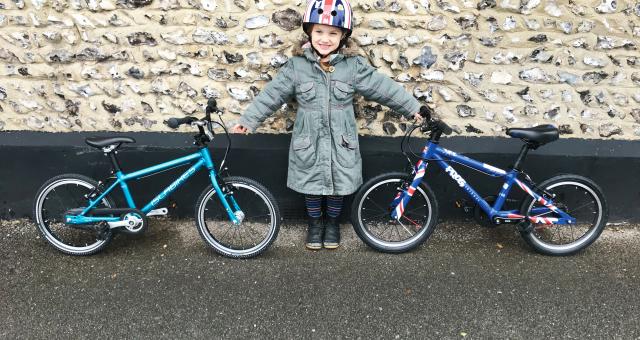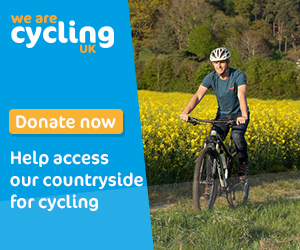How to buy the right bike for your child

Children will tolerate, even enjoy, almost any bike. If you get them a good one, however, they’ll keep using it long after the initial thrill of having a new bike has faded. Good bikes get used, day in, day out, because they’re a pleasure to ride.
Bad bikes, on the other hand, slowly decay in sheds and garages, then end up at the dump. So here’s an impartial guide written by cycling parents to help you choose the best bike for your child.
Cycle prices don’t simply scale down with size. A child’s bike uses shorter lengths of tubing, but smaller components are not intrinsically cheaper and unlike clothes, children’s bikes aren’t VAT free.
However, most children’s bikes are much cheaper because they are built to a price – the kind of price that would buy just a couple of PlayStation games. Be warned, lots of children’s bikes are little more than ‘bicycle-shaped objects’, offering the appearance of a bike but none of its function.
Cheap and nasty bikes don’t last. They break down and are abandoned. A good bike will still be in use several Christmases later and can be handed down to a brother or sister
Dan Joyce, Cycle magazine editor
Buying a secondhand child’s bike
Decent children’s bicycles aren’t hugely expensive. You can get a good bike for a five-year-old for around £250, and a really nice one for a 10-year-old for £300-£400 (estimates based on 2015 prices). There are perfectly acceptable bikes available for less, of course, but with new bikes it means sorting the wheat from a much larger volume of chaff. Bargains are rare – unless you buy secondhand.
Local newspaper adverts or eBay can yield good deals – if you know what you’re looking for. If not, you can minimise the risk of buying a turkey by purchasing from keen cyclists. Cycling enthusiasts will probably have bought something decent in the first place and maintained it. The ‘for sale’ board on the Cycling UK Forum is a great first stop and ads in cycling magazines may also be useful.
Islabikes has a buy-back scheme and sells ex-demo, shop-soiled and secondhand bikes.
Frog Bikes also sells reconditioned secondhand children’s bikes.
A guide to buying the best balance bike

Balance bikes are small starter bicycles for pre-school children. Like the original bicycle, the ‘running machine’ of Baron Karl von Drais, they lack pedals: the rider scoots along the ground, pushing off with alternate feet, and can lift both to coast.
Using a balance bike teaches a child the skills that make cycling possible: balancing and steering. Many also come with a brake. Pedalling might seem a fundamental skill but is easily incorporated later.
A child who starts on a bike with stabilisers will need to learn the more difficult skill of balancing later, and older children may get scared when the stabilisers are taken away. For more information watch our Video: How to teach a child to ride a balance bike.
What to look for when buying a balance bike
Weight
The lighter the better. For a three-year-old child weighing 16kg, the 1.6kg difference between the lightest and heaviest bike here is 10% of their bodyweight. Imagine if your bike were 6-8kg heavier! Also, you will end up carrying a balance bike a lot, possibly all the way home from the park
Steering
A headset with ball bearings will enable the handlebar to turn easily and freely, unlike a plain bearing. Some balance bikes have a steering damper or stop to prevent jack-knifing. Handgrips must be secure. Bulb-ended grips can stop hands slipping off and prevent injury in a fall.
Brake
Shoe soles will stop a balance bike at moderate speeds, but a hand-brake is a useful extra, especially for children who like to whizz around. It also teaches a skill that will be needed later. Make sure your child can actually pull the brake lever: too stiff or too big will only teach them that brakes are useless!
Wheels
Pneumatic tyres are lighter, more comfortable and roll better, especially over bumps. All the bikes tested have 12-inch (ISO 203) wheels. The wheels themselves should spin easily and freely, which they’ll do best with (correctly adjusted!) ball bearings.
Saddle
Look for a comfortable and slightly concave saddle to prevent your child from slipping forward. Adjust the saddle height so that your child can put both feet flat on the floor, raising it as he or she grows. A footplate or rest is useful to stop legs flailing during extended coasting.
For detailed information and reviews on balance bikes read the balance bike group test in the Dec 2014/Jan 2015 issue of Cycle magazine.
There’s more information in A guide to buying the best balance bike.
Cycling UK’s top balance bikes
All of these bikes should stand being passed on to a younger child and should sell at a decent price secondhand.
Islabikes Rothan
This came top in the Cycle magazine balance bike group test, and at 3.5kg this is light enough to carry home from the park or hook onto a buggy. The Rothan’s brake lever is designed for small toddler hands and is easy to pull. It is expensive, but it does sell at around £100 secondhand or you can trade it in at Islabikes for the next size up.
Kokua LIKEaBike Jumper
This all-aluminium bike is the lightest at 3.4kg and came second in our group test. It’s really good on bumpy ground as it has rear suspension, using an elastomer.
It has the lowest initial maximum saddle height of the bikes we tested, so suits two- and three-year-olds, but comes with two seat posts to extend the life of the bike. A brake and mudguards are optional extras.
Hoy Napier
This wasn’t part of the group test, but the spec looks good, with stem and headset bearings, steel spokes and aluminium frame and forks.
There’s no brake or footplate on this bike, but it has angled valves which should make it easier to pump up the tyres. Although, you might have to explain to your toddler who Chris Hoy is!
Frog Tadpole
This weighs 4.17kg and comes in six colours. Like lslabikes, Frog uses scaled-down parts and has an easy-to-pull brake lever, too.
It comes with a bell and it has a five-year warranty – perfect if you have more than one child in the family.
Ridgeback Scoot
Part of the group test, this bike came third mostly because the brake lever was so very hard for our three-year-old tester to pull. Brake lever aside it is a good balance bike.
Pinnacle Tineo
Again this wasn’t part of the group test, but our toddler tester took a spin around Evans on this. We were impressed by the footplate and handy grab handle on the back of the saddle. The brake is OK for little hands too. Please note, this bike is currently unavailable to buy new, but can be found secondhand.
Choosing the first pedal bike – bikes for children aged three to five

It is great to start off using a balance bike, but once your child is confident scooting quickly and stopping, it is time to move up to a bike with pedals.
A word of warning from Cycling UK cycle instructor Julie Rand: if your child is happy on a balance bike, don’t teach them bad habits by moving them onto a bike with stabilisers. For more information watch Cycling UK’s Video: How to teach your child to ride a bike.
Low weight and correct proportions are the priorities for a starter bike, which will have 12in or 14in wheels.
What to avoid
Gimmicks – for example, being overbuilt so as to look like a motorbike or with pictures of a children’s TV character – are best avoided.
What to look for
Look for an upright riding position, courtesy of a BMX-style handlebar, a low stand-over height, and short cranks (90-100mm). Smooth pneumatic tyres roll better than knobbly ones, or tyres that have been filled with foam. The wheels, bottom bracket and headset should all use ball bearings instead of stiff or sloppy plain bearings, where plastic turns on plastic.
Gearing will be single speed, which is fine. The brakes should be easy to operate: do the little finger brake check. V-brakes are effective stoppers, but even better for a starter bike’s rear wheel is a back-pedal brake. A rear brake takes more effort than a front brake due to cable friction and uses the (usually) weaker hand. Using the legs instead overcomes this, and pedalling back to stop is intuitive for a new cyclist.
The best bike of this kind we’ve tested in detail is Islabikes’ Cnoc 14. It’s scaled down perfectly for a small child, with 89mm cranks and a tiny front brake lever. The rear is a back-pedal brake, which gives more reliable stopping. Tyres are treaded for street riding and aluminium tubing keeps weight down to just 5.79kg. The BMX-style handlebar is much easier for learners too.
Frog Bikes also does a very good range of 14" bikes. This bike has scaled down brake levers, mudguards, choice of off-road tyres and even gives you paint to fix scratches. It also comes in a range of six colours. It’s light and stands up against the Islabike Cnoc well, although is a bit heavier at 6.3kgs.
Dawes Academy 14" is part of a range launched in 2014, clearly trying to compete with Islabikes. Dawes has invested in designing shorter cranks an a unique one-bolt adjustable stem. This bike is currently only available secondhand.
Newer to the market are Hoy Bikes with its Bonaly range and Wiggins Bikes, which both make good-quality children’s bikes.
Cheaper options won’t be as light or as well made, yet serviceable bikes are available for under £100 if you shop carefully. The 14in-wheel bikes from Decathlon are a benchmark for value. They come with stabilisers, but those can be removed easily. Unlike most at this price, they use ball bearings and pneumatic tyres. Weight isn’t bad either.
With others, follow the ‘keep it simple’ maxim.
Bikes for children aged four to six

Taller or older children can perhaps go straight to a 16in-wheel bike from a balance bike. Like 12- and 14in-wheel bikes, all 16in-wheel bikes come with a single-speed gear. The chain stays are too short for derailleur gears to function properly, and they would only confuse a young child in any case. As children of this age won’t be riding far, a single gear is fine.
Requirements are much the same as the smaller bikes: low stand-over; ball bearings; pneumatic tyres; decent brakes. A low-ish bottom bracket will help your child get a foot down when sitting on the saddle – which, as he or she can now ride properly, you’ll be gradually raising. Cranks should be 100-120mm but 125mm isn’t too bad.
You sometimes see cheap bikes in this size range with nasty suspension or monolithic steel frames. Avoid – features like this add unnecessary weight and very little else. As with adult bikes, the less you spend, the simpler the bike should be.
Islabikes’ Cnoc 16 is the best of the bunch. It’s essentially the same as the smaller Cnoc 14 but scaled up with larger wheels for a slightly older child. Several other manufacturers offer simple, aluminium-framed single-speeds at around the £250 mark. Ridgeback’s MX16, is a good one, with V-brakes front and rear. The cranks are only a little too long at 127mm. The Dawes Blowfish is a similar price.
Bikes for children aged six to nine
Gears are the obvious extra for 20in-wheel bikes. While single-speeds are still fine, a 3-speed hub gear is even better: it’s easy to understand, easy to use and hard to break. Hub gears are more expensive for manufacturers to fit, though, so 5- or 6-speed derailleurs are what you’ll commonly find.
If the bike does have a derailleur, get a derailleur guard for those occasions when the bike is dropped on its side. A kickstand is useful, as young children aren’t good at propping their bikes up. Look for easy-to-use shifters, like Shimano’s RevoShift twistgrip. Cranks will, once again, be too long. You want 110-130mm; 140mm is too big, but not ridiculously so.
Some 20in-wheel bikes come with a suspension fork, or even full suspension. There are two disadvantages with these: extra weight, and less money to go round elsewhere. If you’re paying a large amount of money for the bike, then you may find that the suspension fork provided is adequate. However, rigid bikes will still give a better return for your money.
One of the better bikes available with this wheel size is also one of the simplest. The Trek Jet 20& is a BMX-style singlespeed with an aluminium frame and a back-pedal brake to supplement its hand brakes. (Yes, that’s three brakes on one bike.) Cranks are 115mm. Despite the low stand-over height, it offers good growing room.
Islabikes have another great bike in this size, the Beinn 20. Puky offers what’s perhaps the ultimate street/touring/ride to school bike for younger children: the Puky Crusader 20-3. It uses a 3-speed hub gear with a back-pedal brake and it’s equipped with everything: mudguards, a carrier rack and even dynamo lighting.
Bikes for children aged eight to 12
As bikes get bigger and start to feature the kind of components you’d expect on an adult bike, so the price rises too. Good-quality 24-inch wheel bikes start at about £300. For that, you can expect a light(ish) weight aluminium frame, aluminium alloy wheels, and brand name V-brakes.
Most mini-mountain bikes from the bigger name brands, including Specialized, Trek and Giant, will have an 18 or 21-speed drive train and a cheap suspension fork; it may even work adequately.
A better option would be a lighter rigid bike with a wide-range 8-speed cassette and a single chainring: it’s lighter, simpler, easier to use and more durable. Most children under 10 only end up confused by a front derailleur and the bike invariably ends up with the chain on the smallest chainring and smallest sprocket, where it runs noisily and inefficiently.
Tyres will have off-road tread on most bikes. Children like the look of these but a set of semi-slicks would be a better compromise. The cranks will again be too long: ideally you want 140mm, but could compromise at 150mm.
A few manufacturers offer road (racing) bikes in this size. As it’s something of a niche market for English-speaking countries, the quality tends to be pretty good and the price high. Expect the components that you would expect, pound for pound, with an entry-level road bike: Shimano Sora gearing, aluminium frame and so on. Also note that the shorter reach that children prefer requires a short stem and short reach, shallow drops.
Yet again Islabikes ticks all the boxes, not only with the Beinn 24, but their smaller-than-usual 26in-wheel bikes, the Beinn 26 and drop bar Luath 26 which can be used for racing or touring. However, most of the big name brands do a reasonable hardtail mountain bike in this wheel size.
The Giant ARX 24 is perhaps the best value. It uses a rigid fork, which saves both money and weight and sacrifices almost nothing in terms of function over a cheap suspension fork. Trek’s Mt 220 is a good one, too: it uses cranks with two pedal holes so you can adjust the bike to suit a growing child’s leg length.
If you have a child who is an off-road fanatic, then high-quality mountain bikes are also available in this wheel size. Kona and Scott have several to choose from. These are real, scaled-down mountain bikes and so the price tags they carry fully reflect that: Kona’s full-suspension Stinky 24 retails for just under £1,000!
Bikes for children aged 12+

Children aged 12 or 13 are ready for a small-framed adult mountain bike with 26in wheels. Many manufacturers make frames down to 14 or 15in, and some do 12 or 13in frames. Trials fans and serious off-road riders may want the smallest frame for the extra clearance over the top tube, but most teenagers can go straight to 14 or 15in.
Unless it’s specifically aimed at children, resist the temptation to put your nine- or 10-year-old on a 26in-wheel bike just because he or she happens to be able to reach the pedals. They will be better off on a 24in-wheel bike, which will probably be lighter and easier to control than an adult bike.
The smaller bike should also have more kid-friendly components, such as cranks, whereas even a bike aimed at small adults will typically have average-sized adult cranks (170 or 175mm). Younger teens would be better off on 150 or 160mm.
The bike industry has been dragging its feet on the issue of crank length for years. So if you want cranks that are the right length for your 13-year-old, you’ll probably have to have them shortened. It costs £50 from cycle engineering company Highpath.
An adult bike means adult prices: expect to pay from £400 for a sturdily built aluminium hardtail frame with a basic suspension fork. The closer you get to £500, the more likely it is the bike will have an adjustable suspension fork (for pre-load, at least), an 8-speed rear wheel (hence, 24 gears) and frame mounts for disc brakes. Some even come with cable disc brakes.
Don’t forget, though, that less is usually more when it comes to quality. Avoid full suspension entirely unless you’re spending a serious amount of money.
Remember, teenagers are acutely aware of peer pressure and will want a bike that’s considered cool. So, decide what kind of bike they want to ride.
Dan Joyce recommends Specialized’s Hardrock, which is available in both 12in and 15in frame sizes and has versions for boys and girls. The Saracen Mantra 1, is even burlier, which many teenagers will like, and is available in 15in. It comes with cable disc brakes too. Trek’s frames go down to 13in. The cheapest ‘proper’ mountain bike is probably Decathlon’s Rockrider 5. The XS size is 15in.
Any cheaper and you’re looking at street/towpath bikes. That’s fine, too, so long as you accept that below £300 you’re best off looking for a bike with no suspension, no disc brakes, fewer gears and no gimmicks. That is, ‘a bike’ rather than ‘an off-road bike’.
One bike for everything
While adult cyclists may have several bikes, most children will at any given time have just one. The ride to school bike, the off-road bike, the bike for cycling in the lanes – they’re one and the same. No bike is best at everything so there will be compromises to make somewhere. Those may include balancing what your child wants with what your child actually needs.
This isn’t an issue with smaller bikes. A decent pavement bike will do everything its five-year-old owner will ask of it. As your child starts to use the bike for longer and different journeys – an issue for bikes with 24in and larger wheels, typically – the need for a bike that’s versatile enough to tackle all those different trips becomes greater.
A hybrid would be ideal, as the name suggests, but there are few – if any – made for children. The next best option is some kind of mountain bike, which your child will be happier with in any case because off-road bikes are more fashionable. Even those that won’t go off road can be good general-purpose bikes. The bike needs to be versatile. It’s a given that it will go off road, but are there eyelets to fit mudguards for weekday street use? Could you fit a rear carrier rack for a school bag, or for that cycling holiday?
This need for versatility will dictate some kind of hardtail – either with a suspension fork or a rigid fork. It’s worth changing the tyres, or at least getting an extra pair. Knobbly off-road tyres might look cool but they are slow and hard work on tarmac.
You could fit semi-slicks – tyres with some tread but not the tractor tyre knobblies of true off-road tyres. Your local bike shop may even be happy to swap them over at point of purchase. Semi-slicks will roll better on the road and will still be okay off road when it’s dry. A more effective option, but one that’s a bit more hassle, is to fit slick tyres to the bike for everyday use and then switch them for off-road tyres the night before singletrack excursions.
Avoiding heavy children’s bikes
Size and weight need scaling down to suit a child. That sounds obvious but Cycling UK has tested tiny bikes for seven-year-olds that were heavier than adult ones. Bike weight is always a bigger proportion of a child’s bodyweight than an adult’s, often as much as a half or a third instead of around a seventh. That only makes it even more important to reduce it. Weight impacts on the fun and manoeuvrability of a child’s bike. Imagine strapping a couple of breeze blocks to your own bike. That’s the kind of extra weight we’re talking about, in relative terms, on some child’s bikes.
The trickle down of aluminium tubing into the lower price brackets means that many children’s bikes are finally getting lighter. While aluminium isn’t inherently better than steel, the way children’s bikes are built nowadays – cheaply, sturdily, with over-size and odd-shaped tubes – it’s a lot lighter. To check a bike’s weight before you buy, you don’t need to take a set of scales to the shop. Just pick the bike up. Then, with careful supervision, see how easily your child can lift it.
Getting the right size bike for your child
Standard cycle components are made to fit the average-sized man. Components for children’s bicycles clearly need shrinking down to suit a smaller rider. Frames and wheels always are, to some extent. With other components, it’s hit and miss.
In particular, cranks are almost always too long. Over-long cranks are ungainly and inefficient. They force the bottom bracket to be higher off the ground to avoid pedal strikes, and this makes it harder to get a foot down from the saddle. As a rule of thumb children need cranks that are roughly one-tenth their overall height, just like adults. So a child 1.2m tall needs 120mm cranks.
You can get a more accurate figure using 20% of leg length instead. To measure that, don’t use trouser size. Instead, subtract height when sitting against a wall from height standing against a wall. That’s your leg length. A fifth of this figure is the required crank length. The cranks don’t need to match to the exact millimetre but the measurement is a good guide. If in doubt, it’s better to err on the short side than long. The problem is that most manufacturers fit children’s bikes with, at best, whatever cranks ought to be on the next bike size up.
The handlebar should be narrower than the 60cm riser handlebar that you might use on a mountain bike, but this isn’t so critical. A wide handlebar is good for control and in a fairly upright riding position isn’t usually uncomfortable. If it is, you can easily cut the bar shorter with a hacksaw.
Brake levers must be within easy reach and the brakes must be easily operable: children have much weaker grip strength than adults. Check that you can reach and work each brake with one little finger. Hydraulic disc brakes are best, but generally cost too much to be fitted to anything but high-end children’s mountain bikes. Smoothly functioning V-brakes are OK. Grip shift-style twist shifters require less thumb strength than Rapidfire levers, and younger children in particular seem to find them more intuitive.
One measurement that doesn’t scale well to children’s bikes is reach – the distance between the saddle and the handlebars. Most children are happier in a riding position that’s both shorter and more upright than you would adopt, so they need the bars higher and closer. BMX handlebars are excellent on bikes with 20-inch or smaller wheels for that reason.
The growing cyclist
Optimum bike fit comes by progressing in stages, rather than fitting your child onto the biggest bike they can pedal. For safety’s sake, your child must be able to get a foot down easily when sitting on the saddle – both feet for learners – and able to stand with both feet flat on the floor while straddling the top tube in front of the saddle. Otherwise there’s an accident waiting to happen.
Children’s bikes can be divided by wheel diameter into five sizes: under 16 inches, 16 inches, 20 inches, 24 inches and 26 inches. These sizes correspond to approximate age ranges, but you might find your child is ready for (or outgrows) a given size a year or two earlier. Also, bear in mind that the use of different frame designs means that one manufacturer’s 24in-wheel bike might be slightly bigger or smaller than another’s.
You don’t have to buy your child a bike at every wheel size, although that would be ideal. Just be aware that a bike with significantly bigger wheels than those your child is used to will make the bike control harder. While a larger wheel will roll over bumps better, it will also be heavier and the steering will be less responsive. The reach to the bars will likely be greater and the bottom bracket will be higher.
Conversely, there will come a time when your child is just too big for that old bike. Two or three years per bike is fairly typical. You can recoup some of your costs by selling on a used bike, or you can extend its use by handing it down to a younger sibling.
Avoid the temptation to buy something cheap and nasty: a bike that barely gets used isn’t a bargain, however inexpensive it is.
Golden rules for buying a kid’s bike
- Don’t buy a bike for your child to grow into. For safety’s sake, it must fit.
- Pick it up. Light weight is vital. Look for aluminium tubing or thin (around cricket stump diameter) steel tubes.
- Be suspicious of suspension – especially at the rear of the bike. Cheap suspension is dead weight that serves no practical purpose.
- Your child must be able to get a foot down easily when sitting on the saddle.
- More gears are not better. Front derailleurs are superfluous until secondary school.
- Consider semi-slick tyres. Knobblies look cool but are hard work.
- Riding position should be fairly upright, with handlebars higher than the seat.
- Try the brakes using only your little finger. That’s equivalent to a younger child’s grip strength.
- If the cranks are much too long, see if they can be exchanged for the next size down at point of sale.
- Less is more. You never get something for nothing. Corners will be cut.
